HMS Eagle (R05)
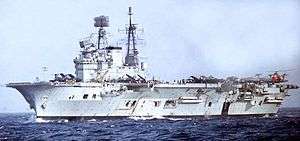 HMS Eagle at flying stations in the Mediterranean, January 1970. | |
| History | |
|---|---|
| Name: | HMS Eagle |
| Builder: | Harland and Wolff |
| Yard number: | 1220[1] |
| Laid down: | 24 October 1942 |
| Launched: | 19 March 1946 |
| Completed: | 31 October 1951[1] |
| Commissioned: | 5 October 1951 |
| Decommissioned: | 26 January 1972 |
| Homeport: | HMNB Devonport |
| Identification: | Pennant: R05 |
| Nickname(s): | The Big E |
| Fate: | Scrapped 1978 |
| General characteristics | |
| Class and type: | Audacious-class aircraft carrier |
| Displacement: | |
| Length: | |
| Beam: | |
| Draught: | |
| Propulsion: | |
| Speed: | 31 knots (36 mph; 57 km/h)[2] |
| Range: | 7,000 nmi (13,000 km) at 18 knots (21 mph; 33 km/h) |
| Complement: | 2,500 (average);[2] 2,750 (max.)[4] |
| Armament: | |
| Armour: |
|
| Aircraft carried: |
|
| Notes: | |
HMS Eagle was an aircraft carrier of the Royal Navy, in service 1951–1972. With her sister ship Ark Royal, she was one of the two largest Royal Navy aircraft carriers yet built.
She was initially laid down on 24 October 1942 at Harland and Wolff shipyard in Belfast as one of four ships of the Audacious class. These were laid down during World War II as part of the British naval buildup during that conflict. Two were cancelled at the end of hostilities, and the remaining two were suspended. Originally designated Audacious, she was renamed as Eagle (the fifteenth Royal Navy ship to receive this name), taking the name of the cancelled third ship of the class on 21 January 1946. She was finally launched by Princess Elizabeth on 19 March 1946.[5]
Several changes were incorporated into the design, although Eagle was launched too early to see an angled flight deck installed, and the ship was commissioned in October 1951. A year later she took part in the first large NATO naval exercise, Exercise Mainbrace.
Service
_MOD_45139760.jpg)
_MOD_45139767.jpg)
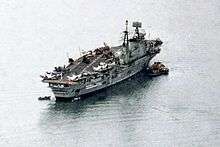
In 1953 Eagle took part in the Fleet Review to celebrate the Coronation of Queen Elizabeth II.[6]
A 5.5 degree 'interim' angled flight deck was fitted in 1954–1955 with a mirror landing sight, but she retained her two hydraulic catapults forward as they were adequate for the relatively light naval aircraft in service at the time. Her first wartime service came in 1956, when she took part in the Suez Crisis. The ship's aircraft of that period included Westland Wyverns, Douglas Skyraiders, Hawker Sea Hawks and de Havilland Sea Venoms.
Rebuild
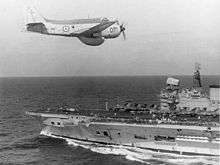
The Admiralty had originally planned to give Eagle a complete rebuild on the lines of HMS Victorious, but due to high costs, plans to fit new geared steam turbines and a stretched hull were abandoned. Eagle was instead given a more austere but extensive modernization that provided greater radar and processing capability than the systems fitted to Victorious. The changes included major improvements to the accommodation, including the installation of air conditioning. The island was completely rebuilt and a new 3D Type 984 radar was installed, with processing capacity to track and rank 100 targets, twice the capability of the early 984 system fitted to Hermes and Victorious. The flight deck was modified and included a new 2½ inch armoured deck with a full 8.5 degree angle, two new steam catapults (BS5s, 151 ft (46 m) stroke on the port side forward and 199 ft (61 m) stroke in the waist) were fitted as well as new arrester gear (DAX I) and mirror sights. As well as an overhaul of the DC electrical systems, AC generators were also fitted to give additional power.
It was decided that Eagle would have her anti-aircraft guns removed and replaced by the Sea Cat missile system, though her aft four 4.5 inch gun turrets were retained, and all of her original machinery and equipment would be fully overhauled.
In 1959 Eagle entered Devonport Dockyard to begin this extensive refit. By May 1964 the refit was complete. Standard displacement had increased to around 44,100 tons (full load displacement was 54,100 tons)[7][8] and Eagle was now the largest aircraft carrier in the Royal Navy. Total cost of the refit was £31 million.[9] The refit was intended to extend her operational life for another 10 years, and Eagle now operated Blackburn Buccaneer, de Havilland Sea Vixen, Supermarine Scimitar and Fairey Gannet aircraft, but water-cooled jet blast deflectors (needed to operate the RN Phantom fighters) were not fitted, and therefore the full potential of the ship was not realized. In 1964-5 it was claimed Eagle and the proposed CVA01 and half sized Hermes would be a viable three carrier fleet until 1980. Victorious would have been replaced by CVA01 in 1973. In reality the 1958 Royal Navy assessment was with affordable modernization of the existing carrier fleet, only HMS Hermes would be effective after 1975[10] and she was too small. These assessments by the Director of Naval Construction in Nov 1958, were very accurate, taking into account the slower than expected pace of reconstruction, corrosion of war built hulls, the obsolete power trains except in Victorious and the cheap unsatisfactory mix of DC electrics with AC add on generators where needed in Eagle and Ark Royal.
Refit
In early 1966 Eagle was refitted at Devonport once more and was fitted with a single DAX II arrestor wire (no.3, her other wires were DAX I). She was recommissioned in 1967.
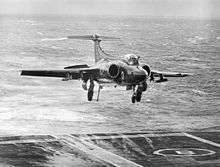
Eagle was originally intended to receive a further refit that would have enabled her to comfortably operate the McDonnell Douglas Phantom (she had already successfully operated them in trials). Her two BS5 catapults fitted in her 1959–64 refit were already powerful enough to launch fully laden F-4s, but her Jet Blast Deflectors were still of the older steel plate design, and the reheated exhaust of the Phantom's Rolls Royce Spey engines required water-cooled deflector plates. It was also planned to fit bridle catchers to the catapults as a cost-saving measure, as the bridles would otherwise be lost after a single launch.
During the Phantom FG1 trials (involving three newly delivered aircraft operated by 700P NAS) the longer waist catapult was used, and a thick steel plate was chained to the deck behind the catapult to absorb the heat of the Phantom's afterburners. The JBD was not used as it would have been damaged, and after each launch fire hoses sprayed water on the deck plate to cool it down before the next aircraft could be loaded onto the catapult.
While fitting adequate blast deflectors and other minor changes for Phantom operation were estimated to cost no more than 5 million pounds in 1968, refitting the ship to operate with a modern airgroup of Phantoms into the late 1970s was clearly going to cost much more, and the new Conservative government in 1970 confirmed plans to convert Hermes to a Commando carrier and withdraw Eagle. In February 1972, the Secretary of State for Defence, Lord Carrington, estimated refitting Eagle to operate Phantoms would cost 25–30 million pounds,[11] and the overall manpower and cost requirements of operating two large strike carriers were beyond Britain, particularly as Ark Royal was expected to serve to the end of the 1970s with only two short refits.[12] To preserve Eagle in maintained or unmaintained reserve would require refits, estimated at around £4m, every 3–4 years,[13] and maintenance crew of 350–400 Navy personnel for 1.5-2 million pounds a year. Reactivation would take four and a half months to a year,[14] while maintaining a Sea Vixen squadron was unjustified expense for aircraft that were obsolete. The refit of Ark Royal cost £32 million to allow operations of a fully modern airwing, though it was generally accepted that even after her return to service she considered to be in a significantly worse overall material state in comparison to Eagle.[15] Of the 48 Phantom FG1s ordered for the FAA, 20 were diverted to the RAF equipping 43 Sqn, though some were loaned back to the Navy to equip the Phantom FG1 training unit 767 NAS which trained both RN and RAF Phantom crews until it was disbanded in 1972.
Decommissioning
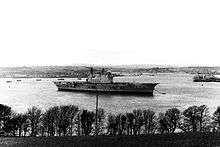
The 1966 decision to run-down the RN fixed wing carrier fleet (Centaur had already been laid up as an accommodation ship, and Victorious was soon to be prematurely scrapped, following a minor fire) meant Eagle's days were numbered. Eagle was paid off in January 1972 at Portsmouth after only 20 years and 4 months of service, and was stripped of reusable equipment (radars and missile systems primarily), after which she was towed to Devonport where she was placed in reserve and moored in a stretch of the River Tamar known as the Hamoaze. In 1974, she was released from her moorings, towed up river, and secured in number 10 Dock, Devonport Dockyard, where she was further stripped of essential spares for Ark Royal, before being towed back to her mooring position.
Up until 1976 she was officially still in reserve, but having been exhausted as a source of spares for Ark Royal, Eagle was then sold for scrap and towed from Devonport on 14 October 1978 to Cairnryan near Stranraer in Scotland to be broken up, clearing her mooring space for her sister and arriving there five days later. The lower hull of Eagle was still being broken up when her sister Ark Royal arrived at Cairnryan for demolition on 28 September 1980.[16] One of her anchors (along with one of Ark Royal's) stands guard at the entrance to the Fleet Air Arm Museum in Yeovilton.
Final Air Wing 1971[17]
- 899 sqn. 12 Sea Vixen FAW2
- 800 sqn. 14 Buccaneer S2
- 849 sqn. D flt. 4 Gannet AEW3, 1 Gannet COD4
- 826 sqn. 6 Sea King HAS1
- Ships Flight 2 Wessex HAS1 (SAR)
See also
Footnotes
- 1 2 McCluskie, Tom (2013). The Rise and Fall of Harland and Wolff. Stroud: The History Press. p. 154. ISBN 978-0-7524-8861-5.
- 1 2 3 4 5 6 7 8 9 10 McCart, Neil HMS Eagle 1942–1978, pub Fan Publications, 1996, ISBN 0-9519538-8-5 page 148
- 1 2 Jane's Fighting Ships 1955–56 page 286
- 1 2 3 4 5 6 7 8 Jane's Fighting Ships 1967–68 page 286
- ↑ Brown 1972, p. 20.
- ↑ Souvenir Programme, Coronation Review of the Fleet, Spithead, 15th June 1953, HMSO, Gale and Polden
- ↑ Gardiner and Chumbley 1995, p. 497.
- ↑ Chesneau 1998, p. 138.
- ↑ Blackman 1971, p. 332.
- ↑ D.K Brown. Rebuilding the RN. Warship Design . Seaforth (2012)UK, p58
- ↑ Hansard HC 22 February 1972,Defence Estimates debate, line 491. Sec of State for Defence
- ↑ Hansard HL 9/3/1972, Defence Estimates debate, lines 296-7
- ↑ Hansard 4/7/1972
- ↑ Hansard 9/3/72. Sec of State for Defence
- ↑ CVA-01 – Navy Matters
- ↑ Holme, Richard, Cairnryan Military Port 1940–1996, G.C.Book Publishing, 1997 ISBN 1872350224 page 38-42
- ↑ "Royal Navy Aircraft Carriers Part 3". Archived from the original 11 October 2012.
References
- Blackman, Raymond V. B. Jane's Fighting Ships 1971–72. London: Sampson Low, Marston & Co Ltd, 1971. ISBN 0-354-00096-9.
- Blackman, Raymond. Ships of the Royal Navy. London: Macdonald and Jane's, 1973.
- Brown, David. Carrier Air Groups: HMS Eagle. Windsor, UK: Hylton Lacy, 1972. ISBN 0-85064-103-9.
- Chesneau, Roger. Aircraft Carriers of the World, 1914 to the Present: An Illustrated Encyclopedia. London: Brockhampton Press, 1998. ISBN 1-86019-875-9.
- Gardiner, Robert and Stephen Chumbley. Conway's All The World's Fighting Ships 1947–1995. Annapolis, Ma, USA:Naval Institute Press, 1995. ISBN 1-55750-132-7.
- McCart, Neil. HMS Eagle 1942– 1978. Cheltenham, UK: Fan Publications, 1996. ISBN 0-9519538-8-5.
External links
| Wikimedia Commons has media related to HMS Eagle (R05). |